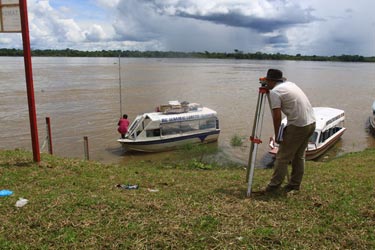Insight: drought and flooding in the upper Amazon
by Jhan Carlo Espinoza, environmentalresearchweb, June 6, 2012
The Amazon basin has been suffering from extreme hydrological events since the 1980s. These have been particularly intense at Tamshiyacu, the most upstream gauging station on the Amazonas River. At this point, the Amazonas drains an area of 750,000 sq. km and discharges around 32,000 cubic metres of water a second.
Droughts affected the Amazon region in 2005 and 2010 while record flooding was observed in the basin in 2009 and 2012. What's more, at Tamshiyacu there was an abrupt transition from the extreme September 2010 drought (just 8,300 m3/s of discharge) to one of the four highest discharges on record (49,500 m3/s) in April 2011. These extreme events have had dramatic impacts on people living near the watercourse and on surrounding ecosystems. Access to clean water is limited and the incidence of disease is increasing. The transport system is also under pressure and crops have diminished.
Peruvian and French scientists from the ORE-HYBAM observatory have provided an initial overview of climate features during these extreme events using comprehensive in situ discharge and rainfall data sets. Results suggest that extreme events are related to surface temperatures in the Atlantic and Pacific oceans that have affected rainfall and discharge, according to the season. Indeed, a warmer than usual tropical North Atlantic during the austral winter and spring, and the related diminished water vapour transport toward the western Amazon explain the lack of rainfall and very low discharge values (for example during the 2010 drought).
The years with a rapid transition from low water levels to increased flooding (such as from September 2010 to April 2011) are characterized by a La Niña-like mode in the central equatorial Pacific during the austral spring and summer. La Niña causes changes in the South American atmosphere, a reduced monsoon flux and a strong convergence of humidity in the western Amazon, favouring high rainfall and discharge in this region.
During the present high-flow period (April 2012), the ORE-HYBAM team has measured a historically high discharge in the Peruvian Amazonas River – 55,000 m3/s. As often happens, upstream impacts downstream and the cities located on the main stem of the Amazon in Brazil are presently under a state of alert.









No comments:
Post a Comment